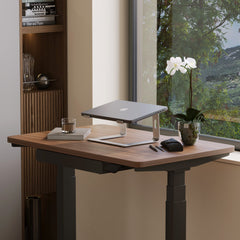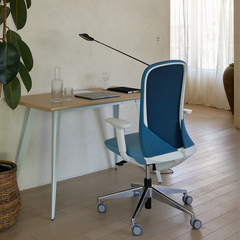Get 10% off your first order
Find the office furniture that’s designed to match your style, comfort, and needs perfectly. Subscribe
The Shape of Focus: How Furniture Design Influences Remote Work Habits

Visit quiz page to see how we makes it easy to create an inspiring workplace

Comfortable seating is not a luxury, it is a productivity multiplier and a health safeguard. The right chair accessories transform a chair into a responsive system that reduces strain, preserves energy, and supports posture through long work sessions. This guide organizes the world of chair add-ons into clear, evidence-grounded choices that fit different body types, tasks, and environments. It also explains how each accessory interacts with posture mechanics so you can build a setup that feels natural, looks refined, and remains comfortable throughout the day.

The spine has a natural S-curve that balances the head, rib cage, and pelvis. Good accessories support this curve without locking the body in place. Micro-adjustments in a headrest, lumbar support, and armrests let the body make small, frequent posture changes. These subtle shifts preserve circulation, prevent muscle fatigue, and keep joints within comfortable ranges of motion. A seat cushion that distributes pressure evenly adds stability to the pelvis, which is the base of upright posture.
Sedentary work often involves repetitive reaches and static neck angles. Over time this creates hotspots in the cervical spine, thoracic region, and lower back. Consistent posture support lowers the demand on stabilizing muscles and reduces the risk of strain. For a balanced view of risk reduction strategies and practical guidance, consult NIOSH ergonomics research on workplace comfort and injury prevention. Use that knowledge to select accessories that meet your body where it is, not where a generic chair expects it to be.
Forward head posture increases load on the cervical spine and pulls the upper back into compensation. A well-placed headrest returns the head over the shoulders, which relaxes trapezius activity and eases eye strain by stabilizing the visual horizon. Proper head support is especially important when alternating between typing, reading, and video calls, where screen height and gaze angles shift.
A multi-axis headrest adjusts for vertical position, depth, and tilt. Height aligns the headrest with the base of the skull, depth meets the back of the head without pushing it forward, and tilt fine-tunes contact through small task changes. This range of adjustment helps different users share a chair while maintaining personal alignment targets.
A tailored headrest integrates cleanly with the chair geometry and follows the arc of the upper spine. The dynamic support system for the neck and upper spine provides targeted contact that is easy to dial in for different statures. Pair it with ergonomic seating built for day-long support to keep the head balanced, the shoulders calm, and the breath unrestricted.
| Headrest Type | Adjustment Range | Best For | Considerations |
|---|---|---|---|
| Fixed pad | Minimal | Short, occasional sessions | Limited fine-tuning, may not fit tall users |
| Height and tilt | Moderate | General office tasks | Good value, check depth adjustability |
| Multi-axis | Wide | Long focus work and shared seating | Highest fit precision, requires initial setup |
Designers, editors, strategists, and developers often enter long periods of deep focus. A plush yet shaping cushion with precise vertical placement supports that focus without encouraging slouching. The custom headrest upgrade for creative professionals pairs with a sculpted seat to maintain an open chest position for better breathing during concept work and review sessions. When used with the contoured seat design with advanced cushioning, the result is full-body support that stays comfortable through iterations and feedback cycles.
The lumbar curve, also called lordosis, is the spine’s shock absorber. When the pelvis tilts backward, the curve flattens and the lumbar discs see higher shear forces. Effective lumbar support lifts the lumbar region into neutral, which also tilts the pelvis slightly forward and reduces stress on the lower back. The key is contact that follows the back as you recline, not a hard pressure point that forces the spine into one position.
An integrated mechanism that responds to movement provides a consistent contact patch through small posture shifts. The next-gen lumbar technology for active posture correction is an example of a system designed to support gentle motion rather than rigid stillness. It allows the back to stay engaged while the body changes angle, which helps maintain circulation and reduces stiffness during long sessions.
Detachable pads fit people who move between multiple chairs or who want a portable option. Choose a pad with contouring that matches your spine and straps that hold position.
Built-in systems work best when you spend most hours in the same chair. They usually offer better integration with seat depth and recline, and they keep support constant as you lean back or forward.
Pressure mapping reveals where weight concentrates on the seat pan. High pressure under the sit bones can cause numbness, while too much softness can make the pelvis sink and the lower back round. The ideal cushion combines surface softness for comfort with deeper layers that set the pelvis in a neutral tilt. Breathable covers and channels allow heat to dissipate, which preserves comfort over time.
A sculpted seat that supports the thighs without compressing them helps keep the pelvis steady and the lower back relaxed. The contoured seat design with advanced cushioning demonstrates how shaping, foam density, and fabric choices work together to create a supportive base that adapts to long typing, creative sketching, and reading.
| Material | Primary Benefit | Heat Management | Durability | Notes |
|---|---|---|---|---|
| Memory foam | Conforming support | Moderate | Long service life | Choose medium density for balance |
| Gel-infused foam | Cool touch and quick response | Excellent | Moderate | Suits warmer rooms and extended sittings |
| Layered mesh | Airflow and light spring | Excellent | High | Good for frequent position changes |
Neutral shoulders require elbow support that meets the forearms at about desk height. Proper armrest width preserves a natural shoulder width, which protects the rotator cuff and reduces neck tension. Angle adjustments help align the wrists for keyboards and pointing devices, decreasing wrist extension and ulnar deviation during work.
People rarely type for eight hours without change. Reading, writing, video calls, and digital sketching demand small adjustments. The multi-angle armrest innovation in the Seashell Chair supports these shifts with height, width, and rotation adjustability so you can maintain neutral joints while changing tasks.
Keyboard-heavy workflows: set armrests slightly forward and close to body width to avoid shoulder elevation.
Tablet or stylus work: outward rotation and a touch lower height for controlled strokes.
Gaming or controller sessions: mid-height alignment with soft top pads that reduce grip tension.
Breathable mesh backs and headrests regulate temperature where contact is continuous. Vegan leather provides a smooth, supportive surface that is easy to wipe clean. Hybrid textiles blend softness with structure. The right choice depends on climate, sensitivity to heat, and cleaning preferences.
Density determines how much a cushion yields. Resilience controls how quickly it returns to shape. Balanced cushions avoid the hammock effect while still relieving pressure on contact points. Overly firm surfaces may restrict blood flow in the thighs, especially for shorter users whose feet do not fully reach the floor.
| Material | Temperature Regulation | Cleaning Ease | Surface Feel | Ideal Setting |
|---|---|---|---|---|
| Mesh | Excellent airflow | Simple vacuum and wipe | Airy and flexible | Warm rooms and long sits |
| Vegan leather | Moderate airflow | Very easy to clean | Smooth and supportive | Mixed-use spaces and shared seating |
| Fabric hybrid | High airflow | Standard upholstery care | Soft with structure | Home offices and creative studios |

Seat height: knees near 90 degrees with feet flat on the floor.
Seat depth: two to three fingers of space between the seat edge and knees.
Backrest contact: steady support at the lumbar curve.
Headrest height: base of skull level for balanced alignment.
Armrest height: forearms supported at desk height without shoulder lift.
1. Set seat height, then check foot contact.
2. Adjust seat depth and lean back to verify lumbar fit.
3. Tune lumbar tension to support natural curvature.
4. Align armrests to desk height and preferred task angles.
5. Calibrate headrest position for relaxed gaze alignment.
Neck tension: headrest too low or forward.
Back fatigue: lumbar support too flat.
Shoulder tightness: armrests too low or wide.
Thigh numbness: seat too high or front edge too firm.
A headrest stabilizes the top of the spine, lumbar support sets the lower curve, armrests reduce shoulder load, and a well-shaped seat anchors the pelvis. When tuned together, the body stays balanced and relaxed. Fine adjustments through the day sustain posture variety and comfort.
| Role or Task | Head and Neck | Back Support | Arm Strategy | Seat Approach |
|---|---|---|---|---|
| Analyst or writer | Multi-axis headrest for stable gaze | Moderate lumbar with recline | Forward armrest position | Medium density cushion |
| Designer or illustrator | Adjustable headrest for intermittent use | Continuous back contact | Outward arm rotation for tools | Contoured seat |
| Customer support | Supportive headrest for headset use | Upright lumbar contact | Mid-height armrests | Breathable cushion |
For users seeking ergonomic seating solutions that merge performance with visual refinement, explore the full designer chair collection. Aesthetic versatility encourages consistent ergonomic habits in any space.
Change posture every 30 to 45 minutes. Small movements—like gentle pelvic tilts or brief reclines—keep joints lubricated and muscles active. This circulation prevents fatigue without disrupting focus.
Every few minutes, take a slow inhale through the nose, hold for two seconds, and exhale gradually. This pattern relieves tension around the shoulders and upper back. Use the 20-20-20 method for the eyes: every 20 minutes, look 20 feet away for 20 seconds to reduce eye strain from screens.
Accessories support posture, but awareness sustains it. Becoming mindful of muscle tension and seat pressure allows you to fine-tune chair settings intuitively. Combining ergonomic design with body awareness ensures consistent comfort across tasks and time zones.
Furniture makers are increasingly adopting low-emission foams, recyclable metals, and eco-certified textiles. These materials not only reduce waste but also maintain durability and aesthetic quality. Sustainability in seating accessories reflects a growing cultural commitment to both personal and environmental wellness.
The next era of ergonomic design emphasizes user-specific calibration. Chairs and accessories that adapt to body data and habitual patterns are emerging as practical evolutions, not futuristic promises. Modular components and user-driven adjustments ensure products remain relevant as needs evolve.
Different climates, work cultures, and spatial constraints influence what comfort means around the world. Breathable materials suit humid regions, while plush cushioning fits colder climates. Global ergonomics recognizes that comfort is cultural as much as anatomical, guiding designers to build accessories that support a wider range of users authentically.
Ergonomic chair accessories are not trends; they are long-term investments in comfort, health, and productivity. Each headrest, cushion, and armrest contributes to how the body experiences work and rest. Thoughtful configuration and consistent movement allow users to work longer with less fatigue, promoting sustainable performance without overpromising perfection. Comfort is achieved not through excess features but through balance—materials that breathe, supports that move with you, and designs that respect the human form.

The Shape of Focus: How Furniture Design Influences Remote Work Habits

Work That Flows: Designing a Home Office That Actually Works

Choosing a Chair for Hardwood or Tile Floors
Get 10% off your first order
Find the office furniture that’s designed to match your style, comfort, and needs perfectly. Subscribe
Leave a comment